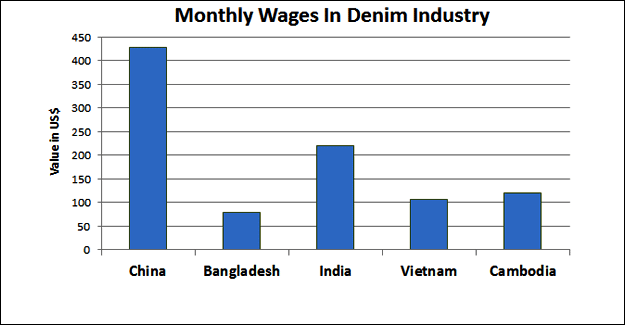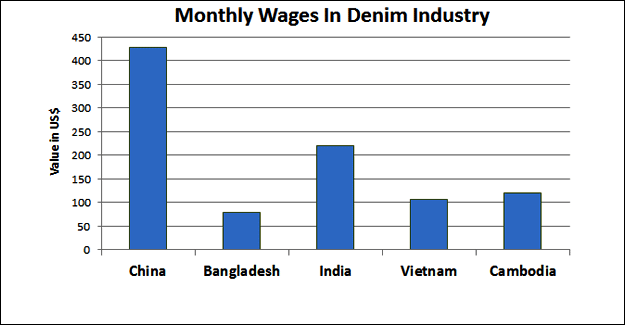
Xintang: China's Jeans Capital Losing Its Sheen
China, an economic producer of textile & clothing (T&C) for years, has started facing a trickle of turbulence for some time now. The economic slowdown in the country after years of aggressive growth, experts say, is making the picture cloudy. Backed by cheap labour and raw materials along with supportive government policy, China's T&C industry has boomed exponentially and became undisputed global leader. Clothing retailers and brands have sourced most of their requirements from the country in post WTO era as it offered very competitive price. The country has helped the clothing retailers and brands to grow to global giants and maximise profits. T&C manufacturing, therefore, have mushroomed to cater to the need of those buyers. The scenario is, however, changing as production costs have gone up and apparel buyers are no longer could squeeze the suppliers to pocket friendly price. While the affect of the slowdown is proliferating across the textile value chain, it has become prominent in cities like Xintang, also known as China's jeans-manufacturing capital. The jeans manufacturers in the city, that makes one pair of jeans out of every five pairs worn across the world, have now found themselves in a sticky wicket as export-led system is crumbling.
Xintang: Jeans Capital Of The World
Xintang, a satellite town of Guangzhou, has been named as the 'jeans capital of the world' due to its large scale jeans manufacturing and trading activities. The story began 30 years ago when a Hong Kong based businessman founded the first jeans factory there with HK$100,000 and 40 old sewing machines. Today, it is home to more than 3,000 firms that deal in jeans and denims, whose over 200,000 workers cut and stitch over 120,000 pairs of jeans per day, according to a local government website. But actual production could be over 800,000 pairs per day! The city cater to all leading jeans brands globally and also home to over 1200 local brands. The Xintang International Jeans and Textile City is the largest hub for jeans production, display, retail and wholesale trade with construction area of 800,000 square meters spreading over 1,000 acres which was built with an investment of RMB 2.5 billion.
Growing Labour Cost
One of the primary fuels that lead the growth of Xintang's jeans and denim industry is the availability of cheap labour. However, this advantage has faded with the increase in labour cost over the last 10 years. According to China's National Bureau of Statistics, there has been a near double digit increase in the national average annual wage for urban employees since 2004. Average wage had reached RMB 56,339 in 2014 (around US$9,000) per annum. So, the era of cheap labour in China is already in history. In Xintang, an experienced jeans factory worker could earn over RMB 4000 per month (US$ 615) with over time. This wage is much higher compared to wage that one worker earns in other competing Asian countries but is lesser than the China's average wage. Thus, jean factory workers could look for other better paying jobs. Looking forward, China has already peaked working population volume in 2012 and deploy workers for more value added work rather than working in sweatshops.
Raw Material Cost And Environmental Concerns
Denim and jeans constitute primarily of cotton fiber while polyester filament yarns have made good inroads in last decade. Further, stretch yarns like spandex are also used. In last three years, local cotton fibers prices were over 35% higher than the global benchmark prices due to the Chinese Govt.'s cotton policy. For instance, Cotlook A Index averaged 70.5 US Cents per pound in 2015 while CC Index (China's cotton index) averaged 94.9 US cents and Indian spot cotton price averaged 66 US Cents for one pound of fiber. The high local raw material cost and controlled import environment for cotton has made jeans manufacturing costly. Another glaring issue that Xintang has faced is high level of pollution due to its denim processing industry. Environmental concerns and growing awareness has compelled the industry to adopt and invest in technology which otherwise overlooked earlier.
Fumbling Economic Growth
China's GDP growth has slowed to its lowest level since 1990s. Its exports, once a pillar underpinning the country's economic miracle, declined last year for the first time since 2009. The fumble economy and tighter margins in the business more businesses have begun defaulting on wage payments in a blatant violation of the Labour Law in Xintang. Xintang's jeans industry is stretched to its breaking point owing to the reasons discussed here but the city's entrepreneurial strengths and supply chain ecosystem will keep its industry alive. However, taking these as opportunity countries like Bangladesh, Vietnam and India could seek to strengthen their position in the trade.

Textile Excellence
If you wish to Subscribe to Textile Excellence Print Edition, kindly fill in the below form and we shall get back to you with details.








